
ATP Meter
While the methods to clean and sanitize surfaces and equipment in the healthcare environment vary, the need to measure the effectiveness of cleaning practices is universal.
Environmental Services (EVS) managers need quick and actionable data to measure the performance of EVS staff and ensure cleaning has been completed according to standards. Using complementary data analysis software, EVS departments can use ATP test results to troubleshoot problem areas in the hospital, evaluate cleaning methods and procedures, and set goals for improvements.
Need ATP Testing for Your New Jersey Facility?
Call 609-709-7988 or Contact Us Now
ATP Monitoring
Chart your way to perfect hygiene. Common Sense ATP Monitoring utilizes SureTrend Software to produce easily interpreted charts to analyze the data and determine continual protocol performance and adjustments.
Read More: What Is A Hygiene Test Scale And Why Use It?
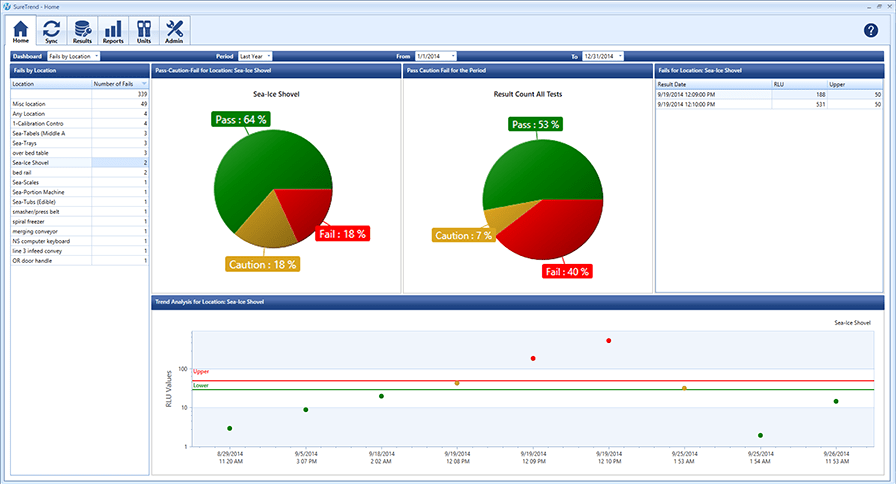
What is ATP monitoring?
ATP monitoring is an ATP rapid method of testing used by food and beverage processors to quickly assess the cleanliness of surfaces or liquid samples from such places as CIP systems.
Adenosine Triphosphate (ATP) is present in all organic material and is the universal unit of energy used in all living cells. ATP is produced and/or broken down in metabolic processes in all living systems. Processes such as photosynthesis in plants, muscle contraction in humans, respiration in fungi, and fermentation in yeast are all driven by ATP. Therefore, most foods and microbial cells will contain some level of naturally occurring ATP. Hygiena luminometers (in conjunction with ATP swabs) use bioluminescence to detect residual ATP as an indicator of surface cleanliness. The presence of ATP on a surface indicates improper cleaning and the presence of contamination, including food residue, allergens and/or bacteria. This implies a potential for the surface to harbor and support bacterial growth.
ATP monitoring is used in food and beverage facilities to confirm that ATP presence is eliminated or minimized by effective sanitation procedures. ATP monitoring prevents cross-contamination, ensures product integrity, potentially improves product shelf life, protects brand reputation, and complies with GMP standards and HACCP requirements.
How does ATP monitoring work?
Hygiena ATP testing devices contain a natural enzyme found in fireflies. This enzyme produces a simple bioluminescence (light-producing) reaction when it comes into contact with ATP. Using bioluminescence technology, the SystemSURE Plus and EnSURE luminometers can measure extremely low levels of ATP collected with testing devices. Measuring the amount of bioluminescence from an ATP reaction provides an excellent indication of surface cleanliness or water quality because the quantity of light generated by the reaction is directly proportional to the amount of ATP present in the sample. The bioluminescence reaction is immediate so results can be processed at the testing site in seconds. Results are expressed numerically on the luminometer screen in Relative Light Units (RLU).
Bioluminescence is the result of a biochemical reaction and is the science behind which Hygiena ATP detection tests. The reaction includes the following elements:
- Luciferin /Luciferase -naturally occurring in fireflies
- Adenosine triphosphate (ATP) – the energy molecule of all living organisms
- Oxygen- a catalyst
- Luciferin /Luciferase + ATP + O2 == == Light output
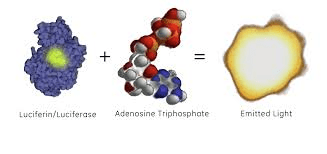
The reaction occurs in two steps:
1. The substrate combines with ATP and oxygen, which is controlled by the enzyme.
2. The chemical energy in step 1 excites a specific molecule (the combination of Luciferin and Luciferase). The result is decay which is manifested as photon emission, or light production. The light is simply a byproduct of the chemical reaction and does not depend on light.
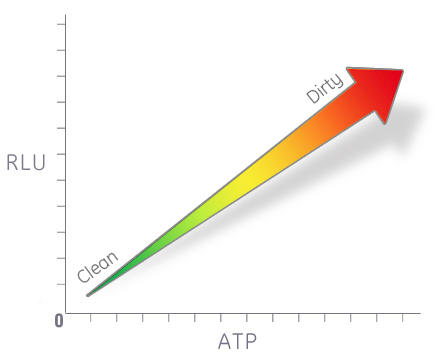
What is an RLU?
RLU stands for Relative Light Unit and is the unit of measure used in bioluminescence. Luminometers measure and quantify light with an RLU output. Because manufacturers use different sensor technologies and algorithms for adding up the photons, RLU measurements will vary from system to system. However, because the ATP bioluminescence reaction is linear, the more ATP present means the more light will be present.
(Comparing RLU values is like comparing Fahrenheit and Celsius; they are two different scales for the same temperature.)
Are there any studies/ white papers on ATP testing?
There are several published articles on ATP test meaning and ATP testing in the food & beverage processing industry. Visit the resources library on www.hygiena.com for links and full texts of many of these studies. Manufacturers offer seemingly scientific research supporting their own ATP systems. It is important for customers to understand that only objective studies conducted by independent laboratories should be accepted as scientific evidence of product performance. Silliker Laboratories, the leading international food testing and safety laboratory, conducted an independent study comparing five commercial ATP systems. This study found that Hygiena’s products offer superior linearity, sensitivity, repeatability, and accuracy.
Can I Compare RLU counts to CFU plate counts?
ATP systems detect the presence of ATP and cannot distinguish microbial ATP from other organic ATP left behind after cleaning. RLU results could potentially be microbial cells, organic ATP from product residue, or both. This makes comparing RLU to CFU difficult. Studies have shown that there is anywhere between 60-90% correlation between RLU and CFU readings depending on the environment in which the system is used. The presence of ATP on the surface indicates that it has not been adequately cleaned. The primary purpose of cleaning is to remove product residue from product contact surfaces. Effective cleaning simultaneously removes the material capable of supporting microbial survival and growth, as well as many of the microbes themselves.
What is biofilm?
A biofilm emerges when microorganisms discover a favorable environment with ample food and moisture. Acting as a cohesive community, these microorganisms excrete a sticky polymer, constructing a sturdy matrix adhering to a surface. Once a biofilm forms, its elimination becomes exceedingly challenging because the matrix reinforces and shields the microbes, rendering them highly resistant to sanitizers. As a consequence, biofilms often lead to compromised product quality and potential product losses due to contamination, inflicting significant financial and equipment damage.
However, the menace posed by biofilms can be effectively countered through proper ATP hygiene monitoring. This proactive approach allows for early detection and removal of food residues, which serves to eliminate the food sources necessary for biofilm formation by microorganisms. Additionally, Hygiena ATP swabs feature a distinctive detergent on the swab tip, capable of penetrating and breaking down biofilms, revealing the underlying cells. In cases where a biofilm has already taken shape, higher ATP levels on a surface would result in elevated RLU (Relative Light Units) readings when tested with the Hygiena ATP surface test.
Conducting sample collection using the single-use test device ensures accurate data for assessing cleaning effectiveness and helps preempt potential food safety incidents. In the event of an issue, immediate corrective action can be implemented based on the light produced, signifying the severity of biofilm contamination and aiding in its prompt resolution.
When should I do ATP testing?
ATP testing should ideally be done after cleaning, but before sanitizer is applied. Because sanitizers are less effective when product residues are on the surface, it’s best to eliminate all ATP before the sanitizer step. In some facilities, testing after cleaning is not possible. In these scenarios testing after sanitizing is acceptable.
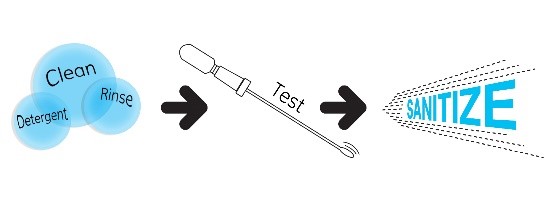

*Thresholds or limits in this chart are suggested values only and do not represent a standard for all industries and facilities. Each facility in each industry should consider setting their clean levels after conducting a series of tests.
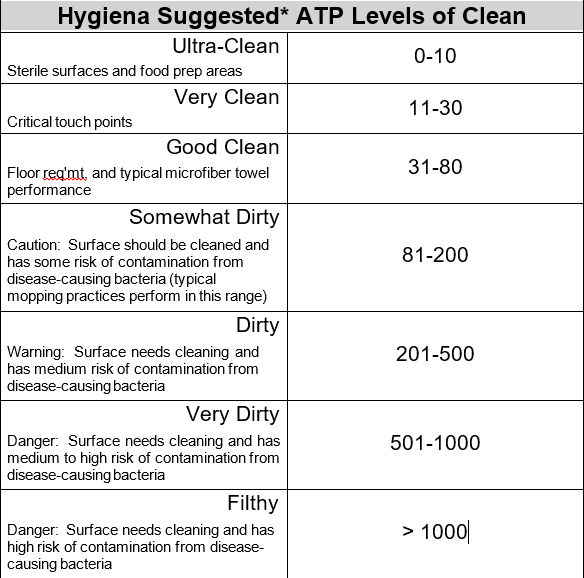
Frequently Asked Questions
Q: What is an ATP Inspection?
A: An ATP inspection is a type ATP testing procedure carried out by authorized personnel in order to ensure that a premise meets the necessary standards for public safety and health. The purpose of an ATP inspection is to identify potential hazards present in the area so that they can be addressed before they pose a threat to public health and safety.
Q: How is an ATP Machine (bacteria measuring device) used?
A: An ATP meter is used to take an APT measurement of the amount of adenosine triphosphate (ATP) in a sample. ATP is a nucleotide that is used for energy storage and transfer in cells. It is important to check the level of ATP in cells because it can be an indicator of cell health. Through ATP swabbing an ATP monitor uses a chemical reaction to measure the amount of ATP present in a sample.
Q: What is an atp cleaning verification system?
A: An ATP hygiene monitoring system is a device used to measure the level of adenosine triphosphate (ATP) in a surface. ATP is a molecule that is produced by all living cells and is used to transfer energy within cells. A high level of ATP on a surface indicates that the surface has been cleaned properly and is free of bacteria and other organisms.
A cleaning verification system typically consists of a reader unit and one or more test probes. The reader unit is used to scan the test probe across the surface to be cleaned, and the level of ATP present on the probe is then measured. If the level of ATP is below an acceptable threshold, then the surface has not been properly cleaned and additional cleaning is needed.

